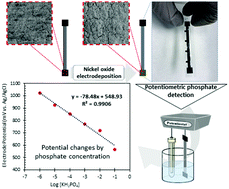Development of a nickel oxide/oxyhydroxide-modified printed carbon electrode as an all solid-state sensor for potentiometric phosphate detection†
Abstract
Phosphate is one of the main nutrients playing many key roles in the human body and plant growth. Because of this essential demand, phosphate is often used as a micronutrient additive in both fertilizers and dietary supplements. However, its excessive amount could result in severe health issues in the human body and the ecosystem of aquatic life. Therefore, there is a need for an inexpensive rapid measurement approach that could assess the optimum level of phosphate by using simple low-cost sensors. Here, for the first time, we demonstrate the use of a nickel oxide modified screen printed carbon (PrC) electrode as a low-cost electrochemical potentiometric phosphate detection sensor. The nickel oxide/oxyhydroxide (NiO/NiOOH)-PrC electrode has been prepared by a facile anodic electrodeposition process onto a screen printed carbon electrode. The characterization performed by field emission scanning electron microscopy (FE-SEM) and energy diffractive X-ray spectroscopy (EDS) techniques confirmed the formation of NiO/NiOOH by significant changes in surface morphology and elemental composition of PrC after electrodeposition. The results exhibited a porous deposited layer containing nickel and an increased oxygen value of the modified electrode as compared to pristine PrC. Potentiometric phosphate detection on the NiO/NiOOH-PrC electrode showed a linear response in the concentration range of 10−6–10−1 M, yielding a slope of −78.48 mV per decade with a fast response time. The electrode demonstrated a stable response with less than 0.8% variability of the recorded potential over 2000 seconds. High durability and reusability of the electrode were confirmed by repeated potentiometric phosphate determination tests over a course of 21 days. Interference tests with chloride, nitrate, sulfate, bromide, acetate, and carbonate solutions revealed very low selectivity coefficients within the range of 10−11–10−2, which indicated a high phosphate-selectivity of the developed sensor. This novel technology provides great potential for future scalable production and applications in portable real-time monitoring of phosphate ions in different precision agricultural and point-of-care diagnostic applications.



 Please wait while we load your content...
Please wait while we load your content...